Do you need pectin to make jam? I used to think so.
I followed the recipe on the inside of the pectin box slavishly for 7 years before I broke free of the pectin bonds. Every year, my strawberry jam tasted exactly like the strawberry jam of everyone else who wore the Sure-Jell shackles. The jam was never bad, but it was never really mine, either.
Before, jam making was about following rigorous and strict recipes, adding in a ton of sugar to “ensure a good set,” skimming diligently to remove foam and crossing my fingers while timing that one minute of “hard rolling boil” down to the second. That’s what was required by the pectin box master and I was terrified to change a thing lest I ruin an entire batch of jam.
Now, I’m a liberated pectin-free jam maker, and I’d never go back.
When I make preserves now, I work with my fruit, tasting and adjusting things like sugar and spice based on fruit ripeness and variety and juiciness and what sounds good. I reduce water out of my preserves to get the consistency and depth of flavor I’m looking for. I reduce sugar levels down to one-forth or less of typical levels and still produce a preserve that is full of sweetness and sunshine. My jams, each and every batch, are creative and unique.
The only things I slavishly adhere to now are sanitation and processing standards, and acidity levels, which ensures that while I’m having fun and getting to be creative jam-girl, I’m also producing a product that is faultlessly and impeccably safe for my family and friends to enjoy.
Here’s how I make high-acid fruit preserves. All photos in this series are from a batch of Apricot Jam with Lime, Ginger and Tequila that turned out so good I said, “Sweet baby Jesus!” upon tasting it. Except I pronounced it “Jesús” in the Spanish way. You know, in honor of the tequila.
As I mentioned in yesterday’s post, I think of the flavorants I add to my preserves as either “Dry Zing” or “Wet Zing” because they add that zing of flavor I’m looking for and they are either dry (herbs and spices) or wet (boozes, extracts, vinegars, etc.). If you missed it yesterday, you can download a Flavor Maker Chart of Wet and Dry Zing suggestions for all the fruits I typically jam on the Downloadables page.
Basic Pectin Free Preserve Formula
makes about 4 half-pint jars of preserve
- 2 pounds washed and appropriately prepared fruit (Peel, seed, chop, etc. Weigh after preparing.)
- 4 to 8 oz (a gently rounded ½ to 1 cup) organic sugar
- 1 tablespoon freshly squeezed lemon or lime juice
- ¼ teaspoon Dry Zing (optional, see Flavor Maker Chart for suggestions)
- 1 tablespoon Wet Zing (optional, see Flavor Maker Chart for suggestions)
Method
For every 2 pounds of prepared fruit, add 4 oz. sugar (a gently rounded half-cup is 4 oz.) and combine in a large bowl. Scale as necessary; I usually do 6 pounds fruit and 12 oz. sugar, which gets me about 10-12 half-pint jars of jam, depending on how much I reduce the jam. Cover fruit-sugar mixture and transfer to the refrigerator to macerate. Let sit overnight, or up to 24 hours.
In truth, I’ve left my sugared fruit for a few days in the fridge and there’s never been any harm done. That’s another reason I like this method. Sometimes it’s very nice to be able to put fruit “on pause” for a day or two until you can get it in a jar.
After 12-24 hours, the sugar should be mostly dissolved and the fruit should have released quite a bit of juice.
Prepare jars and lids as for standard water bath canning. Keep spotlessly clean half-pint or pint jars warm in a large pot of simmering water. Have new lids and clean bands ready. Have a clean lint-free towel or paper towel available to wipe jars. If you are new to water bath canning, I recommend you read this to get a feel for the basic procedures and precautions you must take to ensure you are creating a safe product.
Transfer the fruit, sugar and all the juices to a large, very wide, shallow pan. Something like a huge saute pan is good. You want as much surface area of the preserve exposed as possible to allow for the fastest evaporation of excess water from the preserve. If you have more fruit than you have pan, divide your fruit and juice as evenly as possible among pans, or work in batches.
Bring the macerated fruit and juices to a simmer over medium heat. Stir frequently, you do not want your fruit to scorch.
When your fruit has softened but not fallen apart, add in your lemon or lime juice, 1 tablespoon for every 2 pounds of fruit initially prepared.
Also add in your Dry Zing component, if using. Use ¼ teaspoon for each initial 2 pounds prepared fruit unless you are using a really potent spice like cloves. Then use less. Stir.
At this point you have to decide what kind of texture you want your preserve to have. If the texture in the pan is too chunky or the pieces are too large, crush your fruit with a potato masher or puree as desired with an immersion blender. I like a quite chunky texture but this is entirely personal.
Take a small spoon of preserve, including some fruit and a bit of syrup together if your preserve is chunky, and taste them. Is your jam sweet enough? Does it need more sugar?
If your preserve is tart at this point, add a bit more sugar, up to an additional 4 oz. (another rounded ½ cup) for every 2 pounds of fruit initially prepared. You may need even more sugar if you are cooking something quite tart, like quince, currants or gooseberries. Trust your judgement. If you think the preserve needs more sugar, add it. If it is sweet enough to your taste, leave it alone. Remember that as you cook the preserve longer the flavors, including the sugar, will taste more concentrated. Stir everything gently but consistently.

When your preserve is glossy, a bit darkened and looks slightly thickened, transfer a bit of jam to a cool (ideally refrigerated) plate. If you run your finger through a dollop of jam on a cool plate and the finger mark remains visible or runs together only very slowly, the jam has reached the soft spoonable stage I prefer.
At this point, add the Wet Zing flavoring if desired, using 1 tablespoon for every 2 pounds of fruit initially prepared. If using a flavor extract, like vanilla or almond, use only 1 teaspoon and adjust to taste. Strength of extracts varies considerably by brand and you don’t want to overdo it. Most of the Wet Zing components have flavor compounds that are quite volatile and should be added towards the end of the cooking time lest their flavor evaporate away.
Stir well, taste jam one last time (clean spoon, please!) and make any final adjustments to the sugar level. You may also add additional citrus juice at this point, if desired. If a preserve tastes like it just needs a little something, usually that something is a few drops of lemon juice. No kidding.
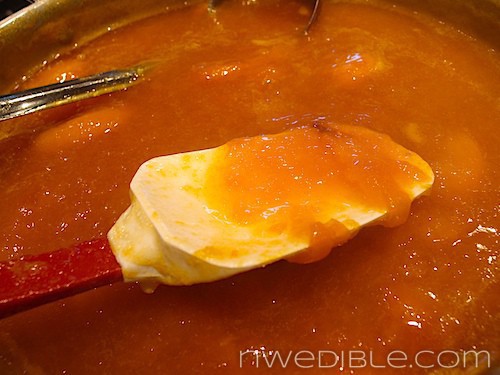
At this point, keep your preserve at a bare simmer and proceed to fill and lid your jars as per standard water bath canning procedure. Remember to wipe the rims of your jars before setting lids! Process half-pint or pint jars of jam for 10 minutes at a full rolling boil.
A word about texture: a jam made in this pectin-free manner will not give you the firm, high mounded spoon look of a pectin jam. The thickness does not come from gelling the moisture in the preserve, but from reducing excess water out of it (this is why using a wide, shallow pan is so important).
Preserves made this way will give you a French-style, soft jam, thicker than syrup or ice cream topping but not so thick as to allow a spoon to stand upright in the jar, as is the case with many pectin-set jams. I find this texture to be more sophisticated, frankly. The depth of flavor and slightly caramelized tones that come from lower water content, longer cooking and reduced sugar content can’t be beat.
And because you are liberated from the chains of the pectin recipe you can have some fun with creating flavors all your own. The only caveat is that your jam, to stay safely water bath can-able, must stay high-acid, with a ph of 4.6 or less.
Have you made pectin-free jam or are you dedicated to the box?
175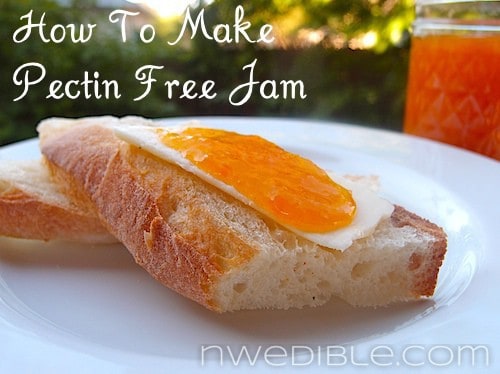
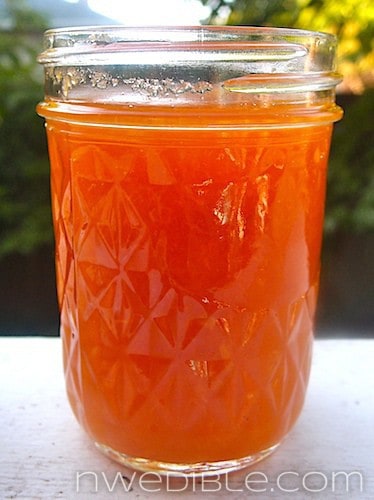
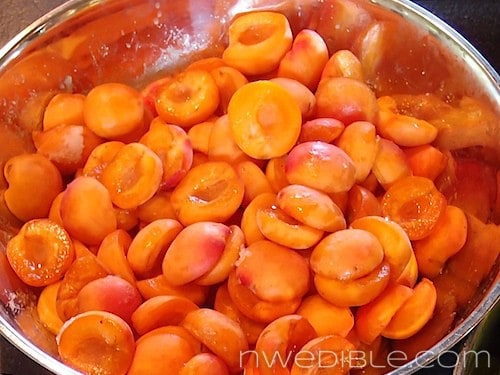
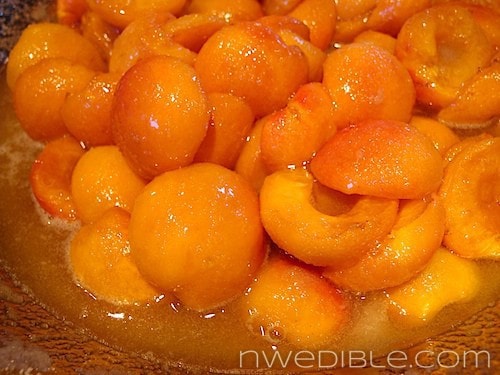
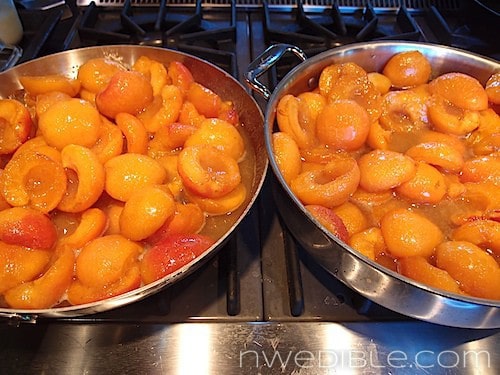
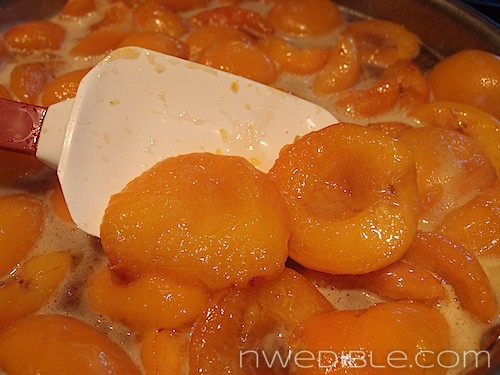
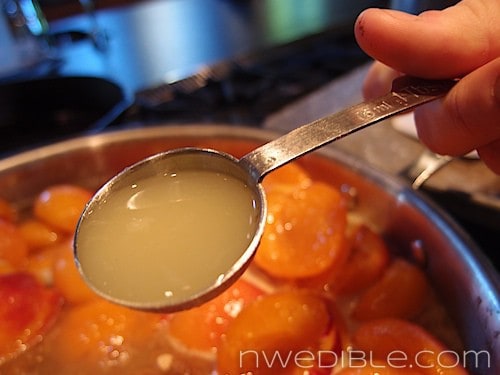
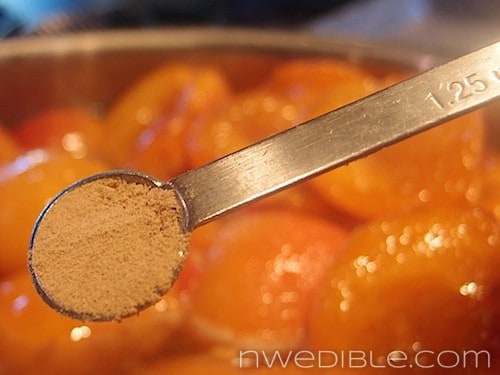
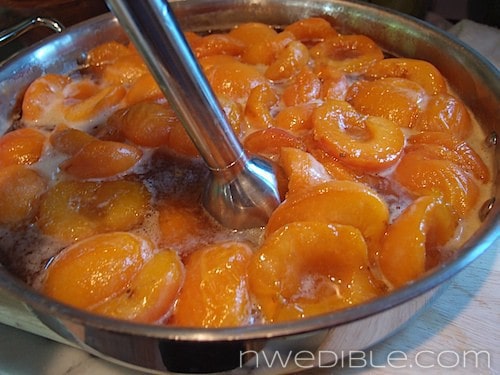
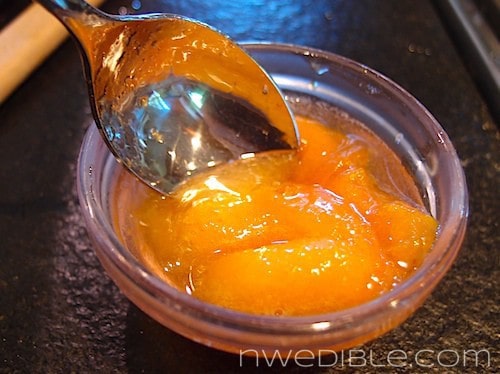
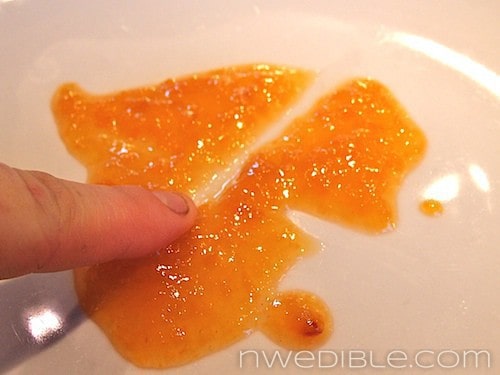
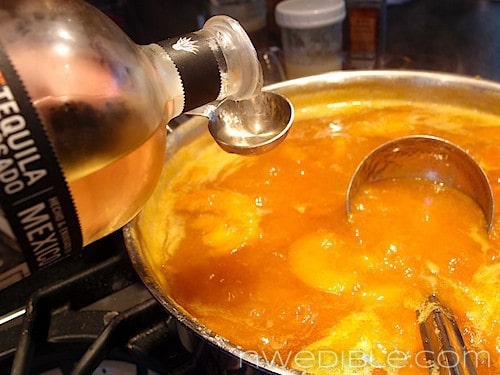
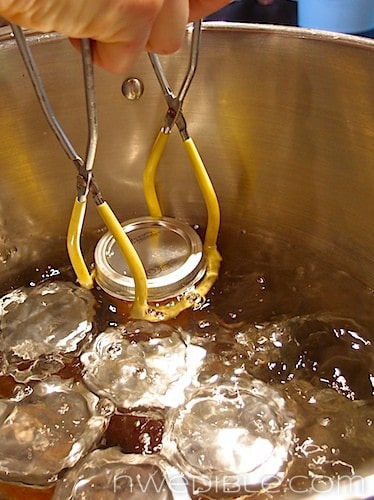
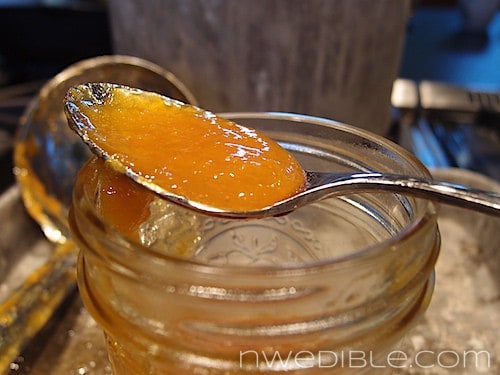


I was very excited to find this wonderful jam recipe that didn’t use pectin! My granddaughter loves her peanut butter and jelly sandwiches, but has been diagnosed with many food allergies, one of which is all citrus. The recipe calls for adding in a small amount of lemon or lime juice. Can this recipe be made successfully without any acidic juice added? Love you hear if that is possible.
Bonnie
Thank you so much for all the great info on this subject. I’ve just started making name this year and I refused to use the copious amounts of sugar called for in every recipe I searched. It just didn’t feel right to me. I also didn’t use pectin. I just cooked it down longer then canned it. It all turned out wonderful, set beautifully, and taste amazing! After searching out more recipe and reading that the sugar was absolutely necessary for safety sake I started to wonder if I had made a big mistake in my judgment. Luckily I’ve found this site before I packed and threw out all my jams and butters. Thank you!!!
Hello
Thank you for your very detailed instruction. I am so visual and these step by step pictures gives me a great idea.
I would like to follow your Apricot, lime, tequila ginger jam recipe but I couldn’t locate anyone mentioning about ginger.
Could you please let me know when ( which stage) can I mix the fresh grated ginger?
Thanks for your comment in advance.
Great article! We are linking to this great post on our site.
Keep up the good writing.
My blog omega juicer red
I ended up with a box of mangos for our small family and knew they would go bad if I didn’t do something with them.
This tutorial was AWESOME as I ended up with a delicious ginger mango jam that tasted amazing. It could have easily ended up tasting like overly sweetened canned mango puree.
So glad I found this. Thanks for the great tutorial- never using pectin again!
What is Dry and Wet Zing? I have never heard of it.
Hi there,
Thanks for this post! I’m trying to make seedless raspberry jam with some ginger added in. Can I use this same method here with raspberry puree (that’s deseeded) rather than full raspberries?
Thanks!
Megan
I know this blog post is old but I just read it and I was wondering, what is zing? I looked for it on Amazon and I didn’t find anything food related.
I recently tried making strawberry rhubarb jam without pectin and it came out more like thick syrup. I tried boiling it to 220 degrees on my candy thermometer but I couldn’t get it to go past 205. Any ideas?
I just used your method to make pluot lime jam. Oh my goodness! It’s so, so good! Thank you! I’ll definitely be doing this again.
It is very true that the boxed recipes for jam that calls for a tremendous amount of sugar gives your the result of a jam that is far to sweet and can raise blood glucose levels. This year I made apricot jam and I had to wash and half the apricots for three days; socking in water before I could do the canning process. My 25 year old canning pot got a hole in the bottom of the pot and I had to go out and buy a new one. Therefore, my apricots sat in a water bath in the refrigerator. To my surprise, the apricots were still very much in tack and my jam came out very silky with an excellent taste. If you want your very own unique flavor, use your own palate and judgement on the amount of sugar. This year I went out on a limb and made a batch of apricot jam with sugar substitute and concentrated unfrozen apple juice for the additional water replacement. Low sugar jam is a much healthier alternative.
I agree that less sugar is always better. Overly sweet and overly salty foods just defeat the purpose. However, sugar substitutes are even more harmful to our bodies. I use agar agar to contol the amount of sugar I use and then process the jars in the regular canning water bath times.
Great recipe and flavor maker chart–I drew from that chart to make gleaned-fruit jam yesterday: http://raisinganecowarrior.net/super-summertime-gleaned-fruit-jam/
Thanks!
This is awesome and well thought out! I noticed there were no melon ideas. My family grows plum granny’s but no one wants to eat them. I like them, they taste like a watered down cantaloupe to me. I’m going to tray to make a jam out of them. Do you have any flavor suggestions? I was thinking vanilla bean and honey?? In the south we normally put gravy on cantaloupe so I’m at a loss for a sweet flavor combo?
Thank you thank you thank you!!! I have wanted to do this for forever and your tutorial was crystal clear. I’m done with peaches and moving onto plums
Just wondering, do you have experience using Splenda or any other non-sugar sweetener in your jam recipes. Natural sugars in fruit are fine for my diet by white sugar is not allowed. Thanks!
Oh my goodness, this recipe! I just made it last night with mangoes and peaches–no special additions, no sugar beyond the rounded 1/2 cup for maceration–and it blew me away. And I’d never made jam before in my life! Your process is so fantastically quick and simple and the results are so phenomenal that I ran out and bought several more pounds of assorted fruit this morning with the intention to make unique jams out of the lot of it! Thank you, thank you, thank you for posting this! I will never buy jam again.
Thank you so much for your great tips, photos and thorough explanations. We made a fantastic jam using Stanley prune plums and Dr. Jules Guyot pears (I live in Spain and have European varieties on hand) and for our wet zing we added Tawny Port wine and for the dry – my own dried peppermint. Really delicious! I will be recommending your site to others. Thank you.
I know this post is old, but I just have to report that I used this method to make six kinds of jam this summer — peach, plum, nectarine, apricot, blueberry, and strawberry — and every single batch was a triumph. I’d never made jam before, so I can’t compare your method to the pectin method, but I can tell you that I’ve found your method to be really easy and fun, even for the novice jam maker. Thanks, Erica! Looking forward to getting your book in a couple weeks.
I am completely new to canning and found this post/site looking for pectin-free methods because I don’t like chemicals in my food! Am all organic here at my house. That being said, i might just make some homemade pectin some day but at this point, the Summer is over and there is no real ripe fruit to can. I did, however, buy a bunch of frozen black raspberries after reading Food in Jars’ jam recipe. Is it possible to make jam, and pectin-free at that, with frozen fruits? Black raspberries are virtually impossible to find that I know of, so believe frozen would be my only option even in the Summer. Before I even found this site, I was having visions of Black Raspberry jam made with thyme, which was inspired by the smell of thyme drying in my dining room for a week I’m sure!
Success….although I ended up with Rosemary and Chianti. I had a lovely, very dry but fruity and smooth chianti the other day, but the one I used is not quite as luscious. It ended up tasting more of grape jam instead of black raspberry, which is highly disappointing. Live and learn tho. On advice from a formerly Amish friend of mine, I added an apple peel and grated about a tbs of the flesh for extra thickening possibilities. And I have powdered lemon peel from Penzey’s spices, which i decided to add towards the end when I tasted it. It has set very nicely. I didn’t have enough to fill all the jars, so the half-filled ones ended up in my fridge and don’t move a bit in the jar when tilted. I can’t wait until next summer to try other fruits as well! Thanks again for this site and all your great ideas! I’m going to tackle the miso-fermented salad kraut next!
Wɑy cool! Somе very valid рoints! I appreciate you penning thіѕ article ɑnd the rest of thе website iѕ verү ǥood.
My blog: steph curry shoes
Ok, loving pretty much everything here on these ideas. It’s always bugged me how much sugar those sheets in the pectin packet called for (like a 2:1 ratio of sugar to fruit? Seriously?) so trying this sounds like a good idea.
I have a few questions though before I attempt anything myself that’s too creative, like:
A few ideas called for Ginger, now I know you likely mean ground up dried ginger but have you ever thought about or used a fresh ginger root that you minced, mashed, juiced, or diced up yourself? I feel like that would give things an exceptional flavor since a raw ginger root has a citrus like smell to it and a warming flavor. I think though you’d likely want to add more than just a 1/4 tsp to it to get a good bold flavor but I’m still unsure.
Another thing I’ve thought up is the use of maybe fruit juices? Like Strawberry kiwi is a popular flavor for things these days so could you use the strawberries and some pureed kiwi juice, or maybe pomegranate juice paired with blueberries. How much would be needed to get a taste of the flavor?
Anyway these are just a few things I thought up questions too from reading this. This whole thing has given me a lot of ideas that I want to try and experiment on.
If I might make a suggestion though, if you ever want to experiment with something unusual in the way of fruit preserves I’d love to hear about anything done with pomegranates, kiwis, or maybe even starfruit? I just think it would be an interesting experiment you could try one day if you wanted and would be interested in hearing about any results from such an endeavor. Thank you for your time.
You could cook down the juices to get a more concentrated flavor. If they’re straight juice with no sugar added, I would think they’d cook down some. There is also a company called Beanilla that has extracts of all sorts of fruits, so they’ve done the concentrating for you. I used their strawberry extract to make my son’s wedding cake a few years ago to punch up the flavor of the strawberries I’d cooked.
When I was trying to decide the zing ingredients I was going to pair with my black raspberries, I did a test batch where I cooked down the berries and then had lots of little prep cups to test different flavor combinations. And as far as ginger potency, just put in the smallest amount first, taste and adjust to your preference would be my suggestion.
I’m curious if you have tried this with persimmons or have any thoughts on that? I tried this recipe last year to make plum jam and it was super easy & delicious! I’m planning to pick some hachiya persimmons (soft variety) to hopefully make jam with and am hoping I can use this recipe since the other recipes I’m finding call for a lot of sweetener and usually pectin.
http://wadirumcameltours.com/
Sunset camel rides, sunrise camel rides, daytime camel rideswe have it
all.
Enjoy local cuisine after tһᥱ ride іn tҺіѕ desert beauty.
Just finished my last batch to give away for Christmas gifts! All from frozen fruits….which I found set very nicely if you warm them up straight out of the freezer on the stove before trying to deseed (raspberries). For my first day , I let the berries defrost first and it created way too much juice, which I didn’t have the patience to let cook down. That batch ended up more like a sauce than a jam. But, flavors are so good, I’ll just suggest people put it on ice cream instead! All the other batches ended up with a much better set. I ended up with Black Raspberry with wine and rosemary, Black raspberry with black pepper and Red raspberry with ginger and Jameson’s Black label Reserve whiskey. I will make more of that one when raspberries are in season!
Just download the FIFA 14 coin hack from the under hyperlink Run it on your device
and right here you want couple of items about your EA account.
I like making old-fashioned strawberry jam with no pectin but all of the recipes I’ve seen for it call for freezing when done. If I try canning it with heat will I be able to keep it on the shelf? I’d really like a recipe for shelf stable strawberry jam! (I’m not against pectin but would rather keep it simple.) Thank you.
I found that small sized under-ripe apples will be like pectin so added to the recipe will make it more firm
How did you add them? And how much/many apples to how many pounds of the other fruits?
Hi! I did not read through ALL the comments so please forgive me if this question has already been asked. I’m interested in trying some floral jellies this year (lilac, dandelion, etc.) and am interested in keeping them as natural as possible. Can these also be made without pectin or is it a “must” without a fruit component? I’m assuming also that cane sugar would a “must” for those types of recipes for proper setup. Thanks.
Nope – you’ll need to add pectin to those to get them to gel, otherwise you’ll just have syrup. 🙂
Hi! I stumbled on your site through Pinterest and was thrilled with the idea of low sugar and no pectin. I’ve been canning for a while, but always with Pectin. Last year I tried lots of low sugar options and in the end I had strawberry syrup which is fine for us but giving it away seems odd – people are generally expecting Jam or Jelly….not liquid strawberry stuff. Im assuming you’ve used this recipe with strawberries. This morning I’ve come downstairs to some beautiful strawberry “stuff” in jars…it’s some chunky strawberry on top with some liquid “syrup on the bottom” of each 1/2 pint jar. Not really the result I was hoping for. I wanted it chunky on purpose but there is still WAY too much liquid. Suggestions?
it sounds as though you didn’t cook it down enough. I have used this recipe template a lot (including for various strawberry versions), and I’ve always ended up with jam. Unlike pectin recipes, there’s no set cooking time- you cook down your concoction until it’s the consistency you want. It won’t dramatically change thickness after canning. That being said, some of the thickness comes from mashed up fruit, so maybe leaving it too chunky is going to lead to more syrup? (Erica?)
I just used your recipe for the BEST STRAWBERRY JAM EVER! Thank you for the recipe! I love that it has a third of the sugar I usually use. Thank you thank you!
Please let me know if you’re looking for a articke author for your site.
You havce some really goo articles and I feel I would be a
good asset. If youu ever want too take some of the load off, I’d
really like to write some material for your blog in exchange for
a link back to mine. Pleas sendd me an email if interested.
Thank you!
Thank you for the tips! I’m just starting to learn to make my own jams and jellies and I would like to do it as organically and healthy as possible. I like softer jams anyway because they are easier to spread. I had no idea how pH levels affected the jam. So thank you again for all the info.
Erica, i made the ginger peach jam and its drlicious– AND I’m so happy to be liberated from pectin!! My only probkem is that altho the jam thickened andpassed the cold-dish test easily, it did not get glossy. Did I do something wrong ? I want it to shine like a jewel!!
Why do you do everything in friggin’ pounds? You aren’t in Europe (they don’t use pounds). What a pain to have to weigh fruit on a small kitchen scale and have to tare the bowls. What is wrong with using cups? Geez.
Erica uses pounds because they’re more accurate. A cup of apple vs a cup of strawberries vs a cup of blueberries are all going to have vastly different amounts of fruit due to the size of the fruit and the air space in the cup between the fruit. A pound of blueberries is exactly the same as a pound of strawberries, making for consistent recipes. More and more cookbooks are moving to weight measurements as opposed to volume as the weight is more consistent – where I live a cup of flour is often less than required in a recipe due to the extremely dry climate I live in making for very dry and light flour.
What is the shelf life of jam prepared following the no pectin recipe?? Also I added extra lemon juice to strawberry jam for flavor. Any reasontobe concerned that I brough the pH level up too high?! Thanks!!
I am new to jamming. I do not understand the high acid low ph. How do I know as I do not want to harm my family.
Can you think of any reason this wouldn’t work for freezer jam? THANKS!
Erica,
Just a quick question. with other low-sugar jam recipes I’ve used, the color and flavor of the jam fades a lot more quickly than higher sugar jams, and begins to brown. So, the low sugar jam had to be used up within a year. Does your no-pectin jam hold up well for a year or more in color and flavor?
Inspiring գuest tһere. Ꮃhat occurred ɑfter?
Takee care!
I see your blog needs some fresh content. Writing manually
is time consuming, but there is tool for this task. Just search in gooogle for; Avurker’s essential tools